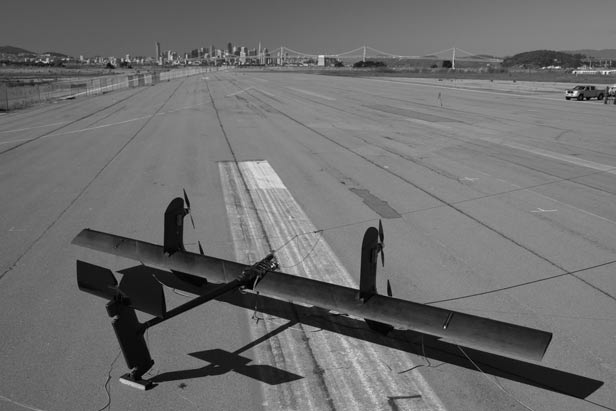Business Impact
Flying Windmills
A small company is taking an unusual tack to produce cheaper wind energy.



In a concrete control tower of a decommissioned naval air base just outside Oakland, California, a team of engineers is building what might best be called a hybrid of an unmanned aerial vehicle and a wind turbine.
The 120-pound craft has rotors on its wings to lift it into the sky helicopter-style; a thin tether attaches it to a platform. Once in the air, the craft begins to glide like a kite, its 26-foot wingspan tracing circles 250 feet overhead. Now the propellers become generators, spinning freely and generating electricity that flows down the taut tether—and, someday, into the local grid.
This craft, developed by Makani Power, is a long-shot bid to tackle one of the world’s toughest problems: getting clean, cheap energy. Currently, wind power costs from five to 10 cents per kilowatt-hour—but the price of electricity from burning coal can fall below four cents per kilowatt-hour. Makini Power, however, aims to bring down the price of wind energy to three cents per kilowatt-hour.
With wind energy, most of the cost of generating power is tied up in building and maintaining huge blades and turbines. Makani believes its vehicle will cost less to build than conventional turbines and will harvest wind energy more effectively, because its flying pattern lets it generate energy under more wind conditions. “The magic is in flying crosswind,” says CEO Corwin Hardham, referring to how the vehicle moves perpendicular to the wind like a kite. “We use aerodynamics to move the rotors many times faster than the actual wind speed.”
The company has carried out a series of test flights, including a flight this fall during which the carbon-fiber prototype with a 26-foot wingspan generated five kilowatts of power. Within two years the company hopes to have an 88-foot wing that generates 600 kilowatts—around a third what a large conventional wind turbine can generate. A gargantuan wing to generate five megawatts is on the drawing board.
The company’s project has drawn some interest from funders. Google has put $15 million into the company, and in September 2010, Makani won a $3 million grant from the Department of Energy’s ARPA-E program, which funds high-risk ideas that could lead to what the agency calls “transformational and disruptive energy technologies.”
Hardham is an avid kite surfer, and in mid-2006 he was working for engineering firm Squid Labs when he hit upon the idea of using similar aerodynamics to generate energy. (In kite surfing, the rider stands on a board and is pulled by a large nylon parachute.) Today, the 20-person company occupies Spartan, military-issue facilities with a machine shop in the rear and an assembly area up front. Composites are baked in a shipping container outdoors; the old control tower’s aerie serves as a lunchroom and occasional bar. Hardham describes the company’s situation as both “humble” and “perfect.” He says, “There’s an obvious advantage to being more nimble than big corporations.”
Makani’s technology is designed to take advantage of the relatively consistent winds that blow well above the ground. Conventional wind turbines top out at roughly 300 feet, with blade tips reaching 500 feet, beyond which it becomes prohibitively expensive to build stable structures. Researching the potential for wind power, Hardham came across a 1980 paper by Miles Loyd proposing a tethered wing that could elevate the business end of a windmill to any height.
The Makani Airborne Wind Turbine consists of several turbines attached to a wing, which is tethered to the ground. In flight, the vehicle takes essentially the same path as the tip of a wind turbine’s blade, following a circle perpendicular to the wind direction. Thanks to crosswind aerodynamics—which produce the rapid circular movements familiar to anyone who has flown a kite on a gusty day—the apparent wind speed hitting the rotors can be as much as 10 times the actual wind speed.
Because the wing makes more efficient use of the wind than a fixed turbine, Hardham says, and is made of fewer, lighter materials, it should produce lower-cost energy. Maintenance can occur on the ground rather than at the top of a wind-turbine tower.
High-altitude wind harvesting still faces skeptics. “It’s a really interesting idea with potentially significant benefits, but we’re early in the process of sorting out whether it’ll work,” says Fort Felker, director of the National Wind Technology Center at the National Renewable Energy Laboratory, in Golden, Colorado. However, he says, reliability, safety, and economics are all concerns. Aerial vehicles designed to harvest wind energy need to be flying most of the time—and there’s always the risk they could “land on a school bus,” says Felker.
Makani is working on addressing the safety questions. To land a craft, battery power is sent to the rotors, letting it transition to a hovering position before being winched back to Earth. Sensors that track factors like vehicle orientation and position, and wind speed and direction, should permit the vehicle to land autonomously, even if it escapes from its tether. Alternatively, a wind farm operator could land a whole field of flying turbines at the touch of a button.
Since the airborne turbines can fly over a wide variety of topography, they’re most likely to be deployed first in windy areas where conventional turbines are hard to install—for instance, they might fly over the ocean. Offshore wind turbines require heavy, expensive foundations and can’t be too far from shore. Makani’s flying generators could be tethered to buoys anchored by cables to the seabed. They could be placed many miles from the coast, says Hardham, where they would be “out of sight, out of mind.”
Hardham says Makani is in negotiation with potential partners about installations offshore of the U.K., and he hopes his initial customers will be large wind-farm developers such as BP and Shell, “who can afford to take a more exploratory approach.”